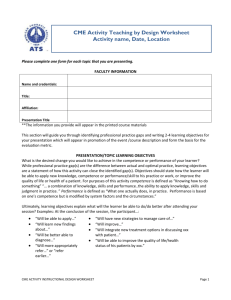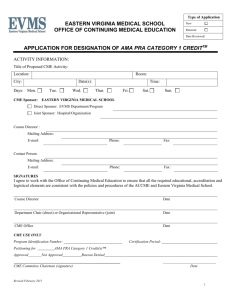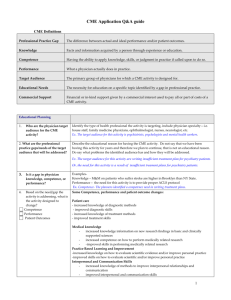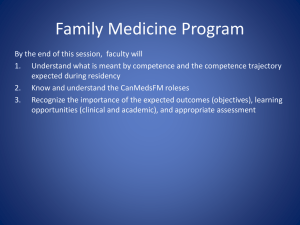CME Application Form
advertisement
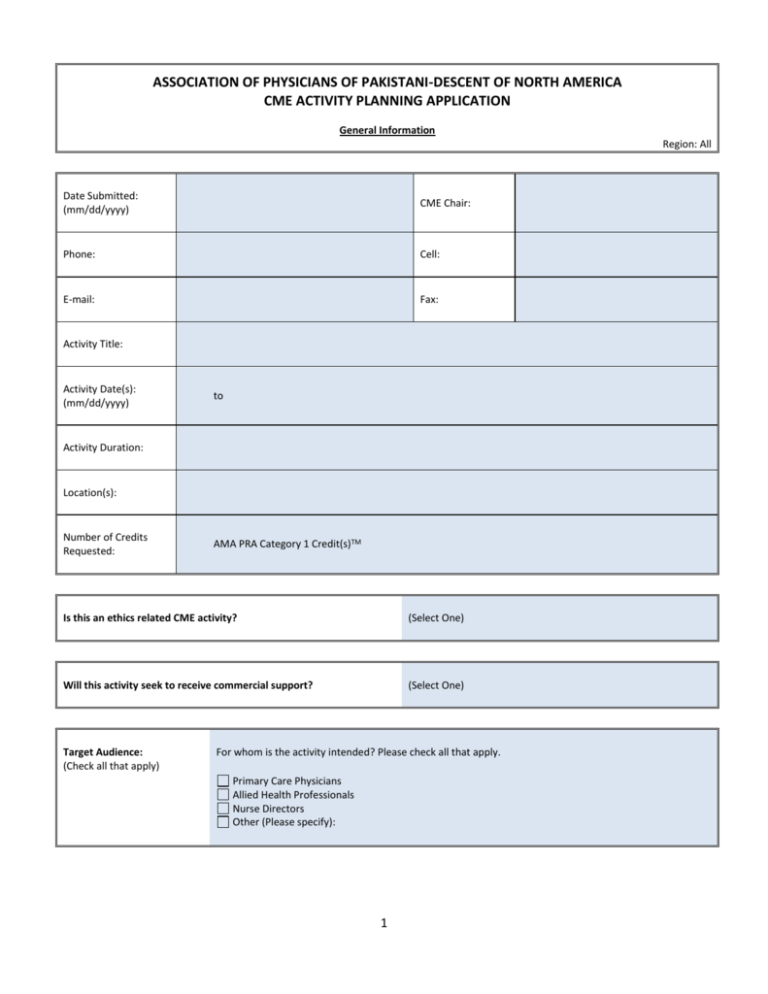
ASSOCIATION OF PHYSICIANS OF PAKISTANI-DESCENT OF NORTH AMERICA CME ACTIVITY PLANNING APPLICATION General Information Region: All Date Submitted: (mm/dd/yyyy) CME Chair: Phone: Cell: E-mail: Fax: Activity Title: Activity Date(s): (mm/dd/yyyy) to Activity Duration: Location(s): Number of Credits Requested: AMA PRA Category 1 Credit(s)TM Is this an ethics related CME activity? (Select One) Will this activity seek to receive commercial support? (Select One) Target Audience: (Check all that apply) For whom is the activity intended? Please check all that apply. Primary Care Physicians Allied Health Professionals Nurse Directors Other (Please specify): 1 PROFESSIONAL PRACTICE GAPS AND EDUCATIONAL NEEDS: A professional practice gap is the difference between current practices and/or outcomes and optimal, achievable (desired) practices and/or outcomes. Consider data from one or more sources to identify the professional practice gap that indicated the need for an educational intervention, and complete the following chart. In column A, briefly describe the current practices and/or outcomes related to that topic. In column B, briefly describe the desired practices and/or outcomes related to that topic. In column C, identify the gap (where learners are vs. where learners should be; by comparing the descriptions in Column A and B). In column D, identify the underlying educational need(s) and type(s) of change needed to close the gap. Options include: Knowledge – having information. Competence – knowing how to do something (e.g. skills, abilities, strategies), which has not yet been put into practice. Performance – the skills, abilities, and strategies one implements in practice. Patient Outcomes – the consequences of actual performance in practice. Note: At minimum, every CME activity must be designed to change learner’s competence, performance, or patient outcomes. Column A: Column B: Column C: Column D: Current Practices/Outcomes Desired Practice/Outcomes Existing Gap(s) Underlying Educational Need(s) And Type(s) of Change Required Example: Example: Example: Example: Physicians do not always recognize the range of atypical signs and symptoms that could indicate the presence of coronary artery disease in women. Physicians recognize the range of atypical presentations that indicate the possibility of coronary artery disease in women. Physicians either do not know about or are not acting upon the atypical signs and symptoms that indicate the possibility of coronary artery disease in women. Knowledge - Physicians need to be informed about what are the atypical signs and symptoms of coronary artery disease in women. 2 Competence – Physicians need to be able to recognize the atypical signs and symptoms of coronary artery disease in women. What data source(s) did you use to identify the professional practice gap(s) and educational need(s) in your audience? (Check all that apply) Literature Review M&M Statistics Expert Opinion Previous Activity Evaluations Other (Please specify): Review the changes listed in Column D. What, if any, barriers might stand in the way of these changes being made? (Examples: formulary restrictions, time not allocated for implementation of new skills, insurance doesn’t reimburse for treatments, lack of resources – time, money, staff, organizational policy, or lack of support.) DESIRED RESULTS (LEARNING OBJECTIVES) List the learning objectives for this activity, as well as how each objective addresses the educational need(s) identified. Use action verbs and specific criteria (see below) in order to measure whether or not the objectives were achieved and the professional practice gap was closed. Also indicate the type of change (competence, performance, or patient outcomes) that is associated with each learning objective. To describe changes in Knowledge/Competence, consider using: Analyze, Assess, Classify, Compare, Define, Describe, Differentiate, Discuss, Distinguish, Estimate, Explain, Examine, Evaluate, Identify, Indicate, Label, List, Name, Outline, Predict, Recall, Recognize, Record, Relate, Review, State, Summarize To describe changes in Performance, consider using: Apply, Arrange, Assemble, Calculate, Categorize, Choose, Collect, Combine, Construct, Create, Demonstrate, Design, Develop, Devise, Employ, Formulate, Illustrate, Interpret, Model, Operate, Organize, Plan, Prepare, Produce, Select, Use, Utilize To describe changes in Patient Outcomes, consider using: Change, Detect, Discover, Enhance, Generate, Impact, Improve, Realize AVOID the following vague or ambiguous verbs: Appreciate, Believe, Comprehend, Conceptualize, Experience, Feel, Hear Upon completion of this activity, the learner will be able to: 1. Educational Need(s) addressed by this objective: Type of change: Knowledge Competence Performance Patient Outcomes Performance Patient Outcomes Performance Patient Outcomes 2. Educational Need(s) addressed by this objective: Type of change: Knowledge Competence 3. Educational Need(s) addressed by this objective: Type of change: Knowledge Competence 3 CONTENT What content will this educational activity include? List the major content areas, in sequence, and briefly describe the rationale for each. Sequence Content Area Rationale for Inclusion 1 2 3 4 5 6 7 8 9 10 Educational Format: (Check all that apply) Lecture / Didactic Case Study Panel Discussion Hands-on Workshops Breakout Sessions Question / Answer Sessions Performance Improvement CME Manuscript Review Other (Please specify): Explain how this format supports your objectives and your desired result(s), (i.e. in changing competence, performance or patient outcomes). 4 What ACGME/ABMS competency is addressed by this activity? Check all that apply. CME committee considers IOM and ABMS competencies during the planning process. The planned activities are focused on clinical competencies (medical Knowledge). Planned CME program is designed to increase physician competency in the area of patient care that is compassionate, appropriate and effective. We educate on the competency of professionalism for improved patient care. Patient Care Medical Knowledge Practice-based learning and improvement Interpersonal and Communication Skills Professionalism System-based practice How are presenters (lecturers, etc.) being informed of the educational objectives? Please document this interaction. (Attach additional pages as necessary.) EVALUATION How will the participant’s achievement of the educational objectives be measured in terms of changes in competence, performance, or patient outcomes? Describe the evaluation process to be used and attach a copy of the evaluation instruments (See sample evaluation questionnaire attached). Evaluations are tools used to determine if the result you intended for learners has actually been achieved. The choice of which evaluation tools to use depends on 1) the goal of the activity; 2) the mode of education; 3) applicability of the tool; and 4) available resources. Please indicate the evaluation tool(s) selected for this activity and the rationale for their selection. (Attach additional pages as needed). Note: A summary of the evaluation results and a list of participants must be received in the CME Office within 30 days following the program date(s). Methods used to determine the activity’s effectiveness in meeting identified educational needs and objectives for which it was designed. (Check as many as apply) Methods of Evaluation Knowledge Competence Pre/Post-Testing without clinical vignettes Pre/Post-Testing with questions containing clinical vignettes Post-activity Evaluation (required) Expert Observation of Procedure Skills 6-8 week Follow-up Survey Other (Specify) 5 Performance Patient Outcomes


